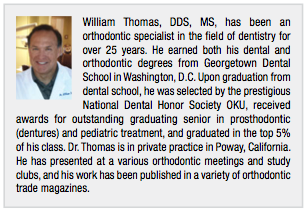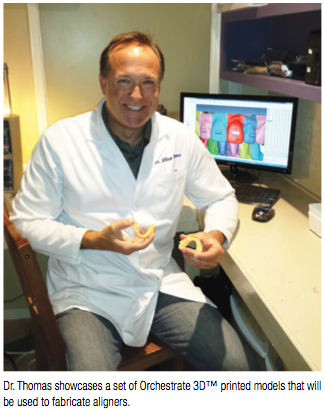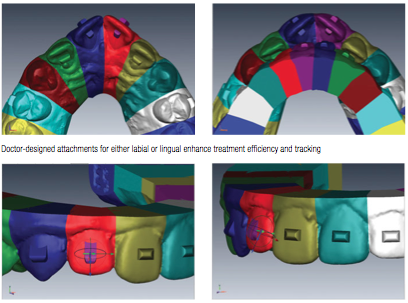Dr. William Thomas discusses an aligner treatment alternative
You have a new prospective patient waiting in your consult room; your treatment coordinator (TC) has provided the patient with the various alternatives to treatment and has informed you that the patient is set on being treated with aligners. The patient records indicate a need for fixed Class II Treatment Mechanics, and the patient’s mandible is somewhat retrognathic.
Your training and experience tell you that the patient needs fixed therapy and does not qualify for pure aligner therapy. Your TC then drops the bomb. She also mentions that they have already seen one of your largest referring dentists and have been quoted a fee for aligner treatment that is 20% less than your fixed appliance fee. So now what?
This scenario is happening in orthodontic offices across the country. Patients today demand appliances that may or may not be optimal for their specific needs. Trying to convince patients and sometimes their parents that certain treatment modalities may not be best for their case is often like trying to sell ice to an Eskimo. Many orthodontists are caught in a variable quandary: “Do I treat the patient with the appliances they desire and make them work, or do I recommend the appliance therapy I feel best meets their dental needs, putting me in an uncomfortable position with my referring dentist?” The resolution most often falls somewhere in between standing firm or losing the case.
Clear aligners and positioners have long been used to straighten and retain teeth. Clear thermoformed plastic with varying degrees of elasticity, formed over models of gradually aligned teeth, have been around the orthodontic world for decades.
My history in orthodontic software used for diagnostics and treatment planning dates back to the mid-1990s when I worked on developing a software program with Dr. Larry Andrews. I helped develop software that prescribed variations in bracket prescriptions based on Dr. Andrews’ Six Keys to Normal (Optimal) Occlusion™ and his Six Elements (6E) Orthodontic Philosophy™. This was developed long before CAD-CAM dentistry made any significant impact in our specialty and was well ahead of its time. Later, as I developed my practice, I joined the Ormco™ training team lecturing on the Damon® System and enjoyed lecturing throughout the world.
During the last decade, there have been numerous advances in digital dentistry. Most of my referring dentists in the San Diego market now offer CEREC customized crowns using the Sirona™ System. In orthodontics, digitally made appliance systems are now a standard alternative for many offices. More recently, intraoral scanning has fast taken hold in orthodontic offices, and I feel we are now reaching the next level of digital orthodontic care.
As I strive to develop improved treatment alternatives, my patients have become more educated and more demanding regarding the appliances they want — esthetics, comfort, and speed being their priorities. In my practice, new patient consults for clear aligners have increased dramatically; however, some of these patients, from my education and training, did not “qualify” for the appliance they desired. Still, these patients demanded more esthetic options without using fixed appliances.
After several years of treating with the available aligners on the market, it began to create a financial nightmare in my practice, driving my overhead up, severely taxing my cash flow, and creating a gradual loss of control in my treatment. Chasing the “volume discount” seemed to me like being on a wheel that kept the reward just slightly out of reach for my “average” size practice. To top that off, many of my cases were not progressing the way I thought they should. Repeated case corrections were often required. In some cases, appliances I received did not seem to track dental movement to a desired optimal clinical level. I worked with various attachment options to make the appliances work better, especially for my Class II patients. Still, I felt limited in what I could accomplish with the appliance systems available.
Additionally, I found that many of my local general dental colleagues continue to offer aligners in their practices, often at a lower fee than mine. It appears to me in my area that approximately 60%-80% of the general dentists are actively providing clear aligner treatment. It seemed like I was caught in a Catch-22, having to re-differentiate my practice and specialty, yet still offer an aligner service to my patients.
Last year, I learned about a new system called Orchestrate 3D™. Orchestrate 3D™ was founded by a group of orthodontists lead by Dr. Todd Ehrler, who developed software that allowed orthodontists to completely control their digital set ups and dental movements.
 Using any open STL file, Orchestrate 3D™ Software enables the doctor and staff to have complete control of determining the velocity of dental movements, allowing a variation of treatment planning that can be more customized to the patients’ needs. So far, I have started over 150 patients with Orchestrate 3D™. Orchestrate 3D™ allows me an ability to provide aligner therapy combining thermoformed materials with variations in thicknesses allowing for a varied modulus of elasticity. Orchestrate 3D™ also allows me to design customized attachments in a variety of geometries, which allow us to better intrude and extrude teeth.
Using any open STL file, Orchestrate 3D™ Software enables the doctor and staff to have complete control of determining the velocity of dental movements, allowing a variation of treatment planning that can be more customized to the patients’ needs. So far, I have started over 150 patients with Orchestrate 3D™. Orchestrate 3D™ allows me an ability to provide aligner therapy combining thermoformed materials with variations in thicknesses allowing for a varied modulus of elasticity. Orchestrate 3D™ also allows me to design customized attachments in a variety of geometries, which allow us to better intrude and extrude teeth.
With Orchestrate 3D™, I am treating cases that I would have never treated with any other outsourced system. I feel like I am in much better control with the Orchestrate 3D™ design software and now have the ability to do practice-designed setups that, in my hands, is better aligned to the biomechanical needs of a specific case.
Analogous to multiple arch wire progressions we have all followed with our fixed therapy, I have developed a systematic multi-thickness progression using varying thicknesses of thermoformed retainer material. In my hands, this has greatly improved tooth movement and what is commonly called “tooth tracking,” along with the ability to completely customize more optimally designed attachments using the Orchestrate 3D™ Smile Design Software.
Using Orchestrate 3D™, the orthodontist determines the velocity of tooth movements he/she feels comfortable with given the case to be treated. Coupled with these doctor-determined movements, clinicians can customize their own attachments using the Orchestrate gyroscope tool. This has allowed me to better control my dental movements in all three dimensions.
Orchestrate 3D™ gyroscope tool
Treatment planning in Orchestrate 3D™ is much more intuitive from an orthodontist’s perspective than other systems where I do not have control. It takes me limited time to work up a case in the software and, more importantly during treatment, fewer headaches when I find appliances not moving teeth in my practice. With Orchestrate 3D™, I continue to be impressed with the speed and efficiency of treatment.
In an effort to maximize tooth movement and tracking, I prescribe two to three vacuum-formed aligners made on each 3D printed model. Initially, I used Dentsply Essix™ in three thicknesses: .030, .035, and .040. I am now starting to use the Forestadent® Track® material fabricated on its Track machine. I am also collaborating with Specialty Appliances lab in Atlanta, Georgia, on expanding scopes of hybrid aligner therapy using fixed Class II appliances along with its manufacturing aligners using my variable thickness aligner sequences.
During early stages of treatment, I desire low initial force systems; therefore, the first two 3D printed upper and lower models are made with vacuum formed aligners using .030- and .035-inch thickness. This enables the dentition and periodontal ligament apparatus the ability to initiate tooth movement and help transition the patient past the initial soreness phase. Occasionally, I use an initial .020 for my initial “adjustment” aligner.
My standard treatment protocol is to use .030 and .035 for the majority of the treatment. When the case has progressed to the final two models, I incorporate a final stage protocol of .030 and .040. If I am really concerned about extrusion and tooth tracking, I’ll include three aligners per 3D model — .030, .035, and .040.
In my practice, this regiment has greatly improved the speed of dental movement through dramatically improved “tracking” and also has seemed to improve my patients’ compliance. In the cases where teeth do not seem to be tracking as fast as I would like, I can go back and adjust the digital setup and get new printed models in a few days. Although I am still finishing many of my Orchestrate cases, I feel as if I use fewer aligners than I used to while achieving the same, if not better, tooth movement.
With Orchestrate, I keep all of my printed models in-house and can fabricate a replacement appliance often on the same day. Once I fully incorporate an in-office 3D model printer, storage of these models will become obsolete. If a specific model is required, it will simply be printed on an as needed basis.
In my practice, the biggest benefits with the Orchestrate 3D™ system are that I see improved control in treatment progression and am able to continually refine tooth movements anytime during treatment with limited additional cost. Typically, I have four to six “setups” or 3D printed models made at a time, on which two to three aligners are vacuum formed on each as previously described. This treatment strategy produces 10-18 aligners per arch and enables changes quickly and efficiently if needed during treatment progression.
Prior to using Orchestrate 3D™, I was locked into a treatment plan and appliances that were predetermined before the patient ever started treatment. With this new technology, I can now make additive clinical decisions and modifications regarding tooth movement and force applications during the course of orthodontic treatment, which has given me much better control of my treatment and a new outlook on using aligners in my practice. 
Further, through my previous experience with aligners, I had limited ability to monitor or manipulate dental tracking easily and efficiently during treatment; therefore, some cases fell behind or had to be retreatment planned. This meant new impressions, lost revenue, lost patient goodwill, and lost profitability. By treatment planning with Orchestrate 3D™, I focus on maintaining facial-lingual and mesial-distal movements to approximately 0.3 mm per stage, and I keep extrusion and intrusion movements down around 0.1 mm per stage. By adding the option for variable force levels delivered by multiple material thicknesses, I have seen dramatic improvement in how fast teeth are moving, and I feel like I am using fewer appliances to gain my desired dental movements due to dramatically improved tracking.
An alternative strategy to enhancing more difficult movements — i.e., extrusion — is to combine simultaneous lingual attachments.
The 3D printed models provided by Orchestrate 3D™ resist tooth fracture better than stone models. Using Pam® as a nonstick material on the printed models enables aligners to be removed easily and efficiently, allowing my lab technician to fabricate multiple aligners on each model easily without excessive breakage.
In some cases, seating attachments are critical to achieve specific tooth movements with clear aligners. Typically these are bonded onto teeth with a high strength composite resin. With the Orchestrate 3D™ software system, precise and completely custom precision attachments are designed by the doctor enhancing treatment efficiency. Initial attachment bonding trays are typically made using .020 thickness Essix™ material. When attachments are used with the Orchestrate 3D™ software, an additional “setup” or 3D printed model is printed along with the aligner models. I term this Stage 0.
With Orchestrate 3D™ software, I have been able to design more optimal attachment geometries that have greatly enhanced the speed of treatment and, in my practice, reduced the number of aligners needed compared to an outsourced lab service. Combined with variable modulus of elasticity retainers we can fabricate in my lab, Orchestrate 3D™ opens up a much broader range of patients whom I now feel comfortable treating with clear aligners. Orchestrate 3D™ also allows me an option to treat patients initially with fixed labial or lingual brackets to achieve difficult leveling and aligning, and then switch finishing with Orchestrate planned finishing appliances. In short, Orchestrate 3D™ has given me an in-sourced system of which I am in full control, both from a treatment aspect and from a practice overhead and cash flow standpoint.
 Prior to using Orchestrate 3D™, we found ourselves trying to convince perspective patients that my clinical training and specialized education was worth a premium fee and large down payment to cover all startup costs. However, for those patients who desired a second opinion and who wanted clear aligner therapy, they often choose to get treatment from a general dentist who offered the same system and a reduced fee.
Prior to using Orchestrate 3D™, we found ourselves trying to convince perspective patients that my clinical training and specialized education was worth a premium fee and large down payment to cover all startup costs. However, for those patients who desired a second opinion and who wanted clear aligner therapy, they often choose to get treatment from a general dentist who offered the same system and a reduced fee.
In the past, I had a choice: Should I reduce my fee, or should I lose the patient start? With Orchestrate 3D™, I feel I can now offer a premium treatment with improved clinical advantages at a cost that allows me to treat patients with the same fee as my fixed appliance therapy. When given the choice of braces or clear aligners — at the same cost — the choice has been a resounding 90% clear aligners.
Now when my TC comes to me with prospective patients who desire therapy with customized aligners, I cannot wait to tell them about this new technology, which allows us improved clinical options and still gives them the clear aligner appliance they desire.
As we learn more about how we can utilize Orchestrate 3D™, I feel my practice continues to embrace new opportunities that we never had before.
My career has been an interesting journey, and I now, once again, look at my cases in a totally new way — through a new paradigm in which clear aligners can finally be highly effective clinically while also financially palatable and cash flow friendly. By using Orchestrate 3D™, my creative treatment planning has only now just begun!
I am now working with Orchestrate 3D™ to help educate clinicians and their staff to realize the same benefits we have enjoyed in my practice. If you are interested in learning more about in-office courses or wish to comment, please email me at
Drt@powaybraces.com; visit the Orchestrate 3D website at www.Orchestrate3D.com; or visit the AlignerPlus™ website at www.AlignerPlus.com for additional information, times, and dates about upcoming courses.
Stay Relevant With Orthodontic Practice US
Join our email list for CE courses and webinars, articles and mores

 Dr. William Thomas discusses an aligner treatment alternative
Dr. William Thomas discusses an aligner treatment alternative
